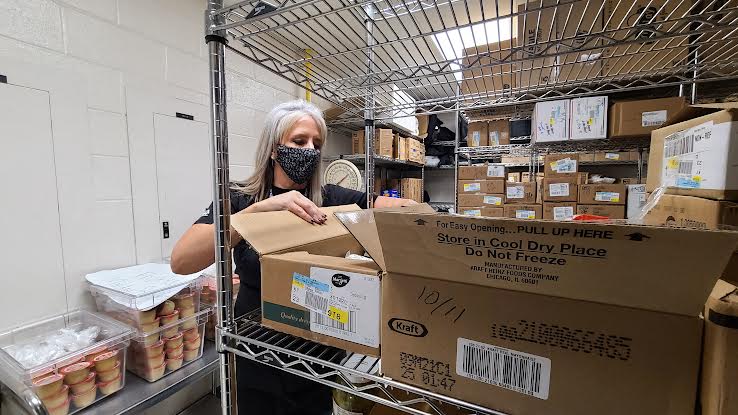Supply chain issues hit local school cafeterias hard
Published 4:24 pm Wednesday, November 24, 2021

- Strode Station Elementary School Cafeteria Manager Karla Courter searches for items in the pantry. - Photo by Warren Taylor.
|
Getting your Trinity Audio player ready...
|
The day after the Thanksgiving meal at Strode Station Elementary, the freezer and pantry space is usually a bit bare.
After all, the food services staff has prepared extra meals to send students and fellow staffers off with a nice turkey lunch before the holiday break.
Replenishing food supplies has become a problem due to the supply chain crisis gripping the United States.
The cafeteria manager, Karla Courter, has a full list of essentials that are becoming harder to come by.
“This is regular menu items,” she said in an interview last Friday. “This is biscuit dough, pizza, hamburger patties, buns … Very basic item needs.”
One underreported shortage is the lack of paper products.
“We have been unable to get food trays, bowls to put our food in, and lids,” Courter said.
The crunch is also felt at the district’s central office.
Becky Lowry, director of food services, has 15 years of experience in school nutrition and has never seen an issue quite like this.
“It has thrown us all for a loop,” she said about the supply chain problems in a phone interview. “Each week, it has gotten worse and worse … Every week there have been more shortages.”
Lowry and the cafeteria managers at each school have done their best to make do until a Friday earlier this month.
“The straw that broke the camel’s back for a lot of us … I was contacted by our prime vendor, and [they] said I had to cancel an order with 150 items on it,” Lowry said. “I needed to get the information back to them within 30 minutes, or they were going to cancel what they wanted to cancel.”
One of Lowry’s responsibilities is ensuring that school meals meet federal nutrition standards.
“We have to be within a certain calorie limit depending on the age group we are planning the menu for,” Lowry said. “It has to be reduced-sodium … It has to be reduced or low fat. It has to be zero trans fat.”
There are even color restrictions. Schools are required to offer red, orange and green vegetables every week.
COVID-19 inspired waivers have opened up the number of food choices for the district to buy, but another issue is the food products it uses are made to meet the nutrition requirements.
“Manufacturers actually manufacture certain products for schools to use that you wouldn’t see out in the grocery store on your shelf,” Lowry said.
Therefore, menu planning has to be done in advance, but revision is required and often necessary due to consistently fluctuating orders.
Cafeteria managers would only have to change menus once every few months in the past. Now they are doing it as many as three times a week.
The constant menu reshuffling is adding to food services’ workload.
“It definitely takes me off the floor when I’m normally on the floor,” Courter said.
Her assistant manager has to take on her floor duties while she is in the office trying to reorder items or find them at other district schools.
“For instance, probably three times this week, I had to go out to get different menu items from different schools,” Courter said.
Without lids, which allow servers to prepackage certain menu items, it increases the amount of manual labor they do ladling individual servings.
It is also taking students longer to get through the lunch line due to servers having to ask them what they want on their plate; an issue exacerbated due to communication issues caused by face coverings.
Even through all the difficulties, the good news is that Clark County students can still get hot meals, and ones with special dietary needs are still easily accommodated.
The bad news is that the issues facing food services will be here for the foreseeable future.
“What they are telling us is that there is no end in sight for this,” Lowry said.





